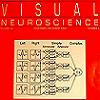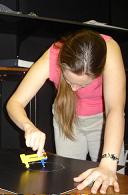July 2012. Warning – I wrote this page in about 2005, and it is now MASSIVELY out-of-date! I will get round to removing or updating it one day, but meanwhile it’s included for historical interest more than anything :-).
Possible designs for a stereo rig
In any stereo set-up, you have to have a way of presenting the two images, one to each eye. Some possibilities are:
Mirror stereoscope — images separated in space.
In a traditional mirror stereoscope, the images are presented on separate screens, or on separate regions of the same screen, and the subject views them through mirrors, such that the left-eye’s image projects only to the left eye, etc. This has been used by most stereo psychophysicists until very recently.
- Pros. The images are perfectly separated; no possibility of cross-talk.
- Cons. Spatial alignment can be fiddly. It is difficult to obtain very large images with this set-up (though certainly possible in principle). If the images are presented on separate screens, these must be temporally synchronised (not a problem with the CRT monitors most commonly used with this system.) Only one person can see the image at once — not a significant disadvantage in an experimental situation, but less convenient when discussing stimuli.
Anaglyphs — images separated in color.
An old technology, but still used by some people in physiology experiments and in MRI scanners. In an anaglyph, the images are superimposed, but the left eye’s image is printed in red and the right eye’s in blue (or green). THe subject wears glasses with a red filter in front of the left eye and a blue one in front of the right, so that the left eye’s image is visible only to the left eye, etc. This was used in 3D movies of the twentieth century; I find it a convenient way of showing stereo images to an audience at conferences etc.
- Pros. Simple and easy. Images are automatically aligned (assuming red and blue pixels are superimposed in your display technology.)
- Cons. Most available filters allow significant cross-talk between the images, i.e. the red image is still dimly visible through the blue filter, and vice versa. Introduces an unwanted colour difference between the two eyes’ images, and likely also an effective luminance difference.
Autostereo — images separated in space.
This is a new technology I know very little about, and I am not aware that anyone has used it for scientific experiments on stereopsis. The idea is that different sub-pixels of the image are visible to left and right eyes (presumably this only works for quite a narrow range of head positions).
- Pros. No need for subject to wear glasses.
- Cons. Relatively small display size. Presumably small differences in image alignment.
Active stereo / shutter goggles — images separated in time.
Here, a single display device flickers rapidly between left and right images, while the the subject wears goggles in which the two eyes are alternately covered and uncovered, usually with polarisation. There’s a variation of this system in which the subject wears passive polarising glasses, and the display device is covered with a “Z screen” which alternates polarisation in synchrony with the display. This is sometimes referred to as “passive stereo”, since the glasses worn by the subject do not contain active components. However, conceptually both are the same, so I shall refer to them both as “active stereo” and discuss their pros and cons here.
- Pros. No alignment issues since both eyes’ images are displayed on the same screen.
- Cons. Introduces a temporal asynchrony between left and right eyes’ images, typically in 2007 around 8ms. For comparison, we found that sensitivity to binocular disparity decays with a time-constant of around 16ms (Read & Cumming 2005 J Neurophys 94:1541, 2005 J Vis 2005 5:417). Severe light loss (depends on shutter duty cycle, but Barco cite 16%, as opposed to 32% with passive stereo using linear polarisation). Allows significant cross-talk between the images, e.g. Nieder & Wagner (2001, Vis Neurosci 18:541) using an active-stereo system with circular polarisation cite an interocular cross-talk of around 11%. Cross-talk can be minimised by increasing the dead-time between images, but this further reduces the effective brightness. Expensive.
Passive stereo — images separated in polarisation state.
Here, the left and right eye’s images are projected onto the same screen and carefully superimposed. Polarising film is placed in front of the left eye’s projector, ensuring that the light forming the left eye’s image is vertically polarised (say) while that from the right is horizontally polarised. The viewer then views the image through polarising film: their left eye views the images through film that passes only vertically-polarised light, so it can see only the image from the left-eye projector.
- Pros. Temporal and spatial misalignment can in principle be eliminated. Any spatial misalignment is immediately obvious (pixels from left and right projectors are not superimposed), so can be constantly monitored and corrected. Interocular cross-talk can be made low (0.3% or an extinction ratio of 300, in my hands).
- Cons. Spatial alignment can be fiddly. Projectors must be capable of being temporally synchronised (see below re DLP). High-quality polarisers and a polarisation-preserving screen are required to minimise interocular cross-talk. A suitable screen will usually have a reasonably high gain (much of the light is re-emitted in a relatively narrow cone), which leads to significant “hotspotting”, i.e. the central region of the screen is much brighter than the edges.
Note that with linear polarisation, the image separation breaks down if the observer tilts his head. This is not usually a problem in a lab, where subjects are typically in a headrest anyway. Circular polarisation is sometimes used in VR-type applications to avoid this. However, circular polarisation can only be induced exactly for one wavelength at a time (in a quarter-wave plate). So the image separation will be poor for most of the wavelengths present in your image. For this reason, circular polarisation gives much worse extinction ratios than linear, and I’m not aware of anyone using it for psychophysics. If head rotation were a concern, nowadays Infitec would be the way to go.
Passive stereo with Infitec — images separated in color.
This is a new technique, passive stereo but with a new way of separating the images. There’s a good description on Barco’s website. Like traditional passive stereo, it involves matched filters being placed in front of the projector and the corresponding eye; like anaglyph, it splits the image by colour. The left-eye and right-eye filters pick out different bits of the colour spectrum — for instance the left filter might pass the low end of the red, green and blue regions of the spectrum, while the right filter passes the high end of each colour.
- Pros. Temporal and spatial misalignment can in principle be eliminated. Any spatial misalignment is immediately obvious (pixels from left and right projectors are not superimposed), so can be constantly monitored and corrected. Interocular cross-talk is very low (0.01% or an extinction ratio of 1000:1, according to Rod Sterling from JVC North American R&D Center, cited by Visbox. No special screen materials are needed to preserve the image separation. So, a very low-gain (ideal diffuser) screen can be chosen, which minimises hot-spotting.
- Cons. As for any passive stereo system: Spatial alignment can be fiddly. Projectors must be capable of being temporally synchronised (see below re DLP). Specific to Infitec: Expensive. Images will have a slight colour mismatch (one bluer, one redder) unless this is compensated for (in software or hardware). More light loss (Barco cites 27% as opposed to 38% with linear polarisation).
ColorCode3d — images separated in color.
I included this for completeness, although I have very little idea how it works, and I am not aware of anyone using it for science. See Colorcode‘s website for details.
- Pros. Only one projector needed.
- Cons. Colour artefacts?
I decided to use the passive stereo method, with either linear polarisation or Infitec to separate the images. I wanted to use projection, to enable me to achieve a much larger display than possible on a monitor. This was important for the work I was planning on vertical disparity; I wanted both to be able to display stimuli in the periphery of the visual field, and to avoid edge effects associated with the visible edge of a monitor. I chose passive stereo because I wanted to avoid the temporal or spectral mismatch produced with active-stereo or anaglyph.
Rear vs front projection
I also had to decide whether to use front- or rear-projection. In front-projection, the viewer and projectors are on the same side of the screen and the viewer sees the reflected image. This has the major advantage of requiring less space. In rear-projection, the projectors are behind the screen, and the viewer sees the image that comes through the screen. The advantage of rear-projection is that the projectors don’t get in the way of the viewer; you can keep a straight line of sight from the projector to the viewer without needing to have the projectors off to one side. This minimises the need for any keystone correction (optical/digital correction for the image distortion caused by having the projector off-axis). I didn’t want to apply any digital processing at all to my images, since I want complete control over every pixel. High-end projectors have an optical lens-shift capability, which enables you to move the images up and down without deviating from rectangular, but this is fairly limited — I’ve found that there is noticeable chromatic aberration if you move the image very far, so that white patches start to acquire green and red borders. So, it’s not ideal to have the projector at too much of an angle to the screen. Another factor which may affect passive stereo systems is that screens tend to degrade polarisation more at larger viewing angles. I haven’t explicitly tested this, but I would expect that polarised light striking the screen normally would have its polarisation preserved significantly better than light incident at many degrees from the normal to the screen. This is another reason for preferring to keep the projectors on-axis. I therefore decided to use rear projection in my system.
Choosing projectors for a passive stereo system
I then faced the issue of what projectors to buy. There are several basic technologies (see e.g. here for an introduction). Here is what I have gathered about the pros and cons of each. See also this comprehensive guide to CRTs/LCDs by Michael Bach, Thomas Meigen and Hans Strasburger.
CRT (cathode ray tube)
. You might think CRT projectors are a thing of the past, but they are (as of 2007) still advertised on Barco’s website.
- Pros. According to Barco, they “allow for the highest resolution large-screen images, with unprecedented visual fidelity.” They also allow high contrast: their “black” really is black.
- Cons. Very large, heavy and expensive. Low light output (100s of ANSI lumens, a factor of 10 lower than LCD or DLP projectors), although this may not be a problem in a lab setting. Red, green and blue components of the image are projected through separate lenses, so the three component images of a single projector must be painstakingly aligned, in addition to aligning two projectors together. This could be avoided by only using a single colour gun.
LCD (liquid crystal display)
- Pros. Probably the cheapest projector technology.
- Cons. Low contrast compared to DLP. Low temporal resolution — pixel luminance is changed when the crystal rotates to change its polarisation state. This happens relatively slowly, so LCD projectors are not capable of displaying fast temporal flicker at high contrast. So, for dynamically updated images, they may introduce contrast artefacts — a fast-moving grating may be displayed with lower contrast than a slow one with the same notional contrast.
DLP
(digital light processing).
- Pros. Higher contrast than LCD, although “black” still transmits some light. High temporal resolution — able to display moving stimuli without any loss of contrast.
- Cons. More expensive than LCD. Lower-end “single chip” DLP projectors use a colour-wheel which displays first the red, then the green, then the blue image in quick succession. This causes several problems. (1) The “rainbow effect”, when subjects are aware of brief flashes of the different colours. This is most likely when the image contains bright objects on a dark background, or the eyes move across the image. It can be reduced by using colour wheels with more segments, so that more RGB repetitions occur per frame. (2) The image display has to be synched to the colour-wheel. In most DLP projectors, the colour-wheel is not synched to the vertical refresh signal. Thus, in a typical DLP projector one knows only that the image will be displayed at some time during the frame, but there is no guarantee that two DLP projectors receiving identical vertical refresh signals will display their two images at the same time. High-end “three chip” DLP projectors do not use a colour-wheel; they display all three colour components at once. They do not suffer from the rainbow effect, and I assume they synchronise to the vertical refresh. However, they are extremely expensive.
LCOS
(liquid crystal on silicon).
- Pros. I believe this usually has higher contrast and light levels than LCD. It also avoids the “screen door” effect, whereby individual pixels are visible when up close. It does not suffer from the rainbow effect.
- Cons. This technology was proprietary to JVC for many years, and so was not widely exploited. Thus it is unusual to find LCOS projectors, and I have the impression they are usually expensive.
When I initially set up my lab with my funding from the Royal Society (2005), I could not afford DLP projectors. Instead, I bought two LCD Matrix 2500 projectors from Christie Digital. My experiences with this set-up are detailed here. I found that this set-up was adequate for my needs, although I’m now looking to replace it with something higher-end. In particular, I was relieved to find that the two projectors did indeed synchronise perfectly. I have little feeling for how unusual this is. Most stereo rigs are used for visualisation, etc, where precise synchrony is not required, so it’s hard to find information on this from company websites. I have been told that “most lower-end projectors” are not synched to the vertical refresh, and that only simulation-standard projectors have this property. I would be interested in hearing other people’s experience on this, since it seems that finding projectors that can be synchronised may be one of the major cost factors in setting up a passive stereo projection system suitable for psychophysics.
Off-the-shelf passive stereo projection solutions
Having now been awarded a grant from the MRC (2007), I am researching more sophisticated systems. I’m particularly interested in improving the temporal response (moving to DLP), the alignment (having the projectors held in a specially-designed frame where minute adjustments are easy), and the image size (e.g. by using smaller projectors which require less clearance from the wall, so maximising the throw distance). I’d also like to improve the contrast beyond the 2500:1 available with my Matrix 2500s. The precise specifications I have in mind are:
- I need the images supplied to left and right projectors to be displayed exactly in synch (to within 1ms).
- I need the images to be precisely aligned, pixel by pixel, without any digital correction.
- I want a fast temporal response, to enable me to display (e.g.) drifting gratings without losing contrast.
- I want to achieve a very large image size (ideally 2m or so across) within a lab about 7m long.
- I want as high contrast as possible (2500:1 or better).
- I want as high resolution as possible (SXGA or better). Realistically, these last two will be limited by cost.
It seems to me that these requirements imply DLP projectors which synchronise to the vertical refresh, which have optical lens shift, and which are held in a frame which allows very precise alignment. The only single-chip DLP projectors I have found which synch to the vertical refresh are made by the Norwegian company ProjectionDesign, distributed in the UK by RGBComms. These synch to the vertical refresh when operated at their native frame rate of 60Hz. For example, their F2 projectorseems to fit the bill. It has a resolution of 1400×1050 (SXGA+), is 3000 ANSI lumens, and has a contrast of 2500:1. For comparison, my Matrix 2500 projectors are 1280×1024 (SXGA), 2500 lumens and contrast of 700:1. The F2 is also a lot smaller and just one-seventh of the weight! So, it looks as if whatever system I get will have to use ProjectionDesign projectors.
One option is to go for another “home-made” system, where I just buy two suitable projectors and put them in a suitable frame, either one I buy or one the workshop makes for me. Studio3D seems to reckon this works OK, using “a Chief slide projector stand for easy alignment.” However, they may not be as fussy about alignment as I am. Also, two ProjectionDesignF1 SXGA+ projectors from RGBComms would set me back £16,000 according to their website (March 2007), which is a high fraction of the price for a complete “turnkey solution”.
Alternatively, I’ve found several companies which offer passive stereo projection solutions. I aimed to find all companies which could potentially suit my requirements. I’ve also included others I came across, even where they did not fit my needs, in case these are of use to someone else with different requirements. As a rough indication, I’ve put prices where these are available or I was quoted an estimate. However, the price will depend on exactly what you end up getting (lenses etc) and will of course change anyway, so this is just a rough indication.
Virtalis StereoWorks
Based in the UK. They were very helpful and knowledgeable, arranging a visit to a local university which has one of their systems and designing a set-up which takes all my requirements into account. We are going to their offices in Manchester for a demo.
Cyviz Viz3d
Based in the US; distributed in the UK by RGBComms. Very helpful and knowledgeable. Their Viz3d seems to fulfil all my requirements. ProjectionDesign DLP projectors synched to vertical refresh, 1400×1050, in an adjustable frame. Bruce Cumming at NIH has one of these, and says the frame allows alignment to within 1 pixel in about 10 minutes. $25,000.or $32,000 with 1:1 lens
Immersaview/Visbox VisDuo
Based in the US but can supply to the UK with an international warranty. Again, very helpful and knowledgeable. They don’t use single-chip DLP projectors because of the rainbow effect. Their standard VisDuo range comes in a range of resolutions and luminances, up to 1920×1080; only uses LCD projectors; costs $21-$32k depending on specs. They offered to make a special version of this which would meet my needs. It would use high-end LCOS projectors which synch with the vertical refresh, and offer 1920×1080 resolution, 500 lumens, and 2000:1 contrast. Including 1:1 short throw lenses with subpixel geometric distortion, the two projectors, stacker and stand would cost $45,000. Rather outside my budget, but I was very impressed with the way they got to grips with my needs and designed a system to fit them.
Digital Image Cube 3D
Based in Germany. Again, I found them very helpful. Cube 3D uses 1024×768 DLP projectors. Takes only VGA inputs, not DVI. Their DLP projectors are not synched to the vertical refresh, so images would be out of synch. They offered to build me a system using ProjectionDesign DLP projectors, which are synched, but were pessimistic about the chances of achieving pixel-perfect alignment across the image. Since I’m based in the UK, they suggested I try Virtalis.
Inition Duality
Based in UK. Only an auto response received so far. Low-end LCD XGA system £9,450 = $18.5k
More3D Morpheus
Based in Germany. Not heard back from them yet. The Morpheus system comes in a range of resolutions and luminances. 2x3500lumen DLP projectors, 1400 × 1050, 25k euro = $34k.
3Dims
Based in Germany. Quick and helpful response to my email. They suggested a system with 3-chip DLP projectors, 1280×720, 6000 euros.
Infitec
Based in Germany. As well as making the Infitec filter technology, they appear to offer complete stereo projection systems. Not heard back from them yet.
Barco
Based in US. Their webpage suggests they may make something suitable. Not heard back from them yet.
Christie-Digital Montage LX3
Based in the US but with distributors in the UK. When I bought my Matrix 2500s from Christie, I found their sales staff very pleasant & helpful, but not so good at answering the kind of very specific technical questions I was posing. The Montage is quite an old system (2002), using LCD projectors with XGA resolution, so not suitable for me. They don’t seem to offer another set of projectors in a custom frame, although I know other companies use Christie projectors in their stereo systems.





















This may be a silly question but I am interested in stereoscopic images for wall mounted art: is this possible? I realize the major limitations are accuracy and image resolution. Is it possible, even with high resolution photography, to create a stereo-set mounted on the wall and view them in 3D?
Hi John,
I would have thought your best option for that might be lenticular 3D. You’ll be familiar with that from posters and novelty items. You can get companies to print custom 3D images in this way, e.g. https://hiveassociates.co.uk/ (disclaimer – I have no connection with them, haven’t used them, found them by googling).
Would that suit your purpose, do you think?
Best,
Jenny